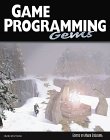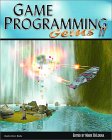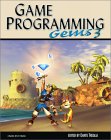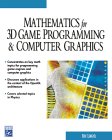
Mark DeLoura
Table of Contents:
MATHEMATICS OVERVIEW (Algebraic Techniques, Trigonometry and Geometry, Linear Algebra, Matrix and Vector Operations, Advanced Mathmatics)
GRAPHICS PRIMITIVES (Ray/Polygon/Polyhedra Intersection, Algorithms, Handling Large Amounts of Polygonal Data, Triangle Stripification and Fanning Algorithims, Using 2D and 3D Billboards)
LIGHTING (Multi-texturing to Achieve Lighting Effects, Shadow Algorithms, Using Simple Radiosity, Projected Texture Lights)
TEXTURING (Using Texture Matrices, Bump Mapping and Environment mapping, Procedural Textural Mapping)
DYNAMIC POLYGON CONTROL (Parametric Curves and Surfaces, Subdivion Surfaces, Multi-Resolution Meshes, Spatial Partitioning Schemes, Camera Techniques/Movement Techniques)
GRAPHIC EFFECTS (How to do Lens Flares, Weather Techniques, Sky Domes, Effective Clouds & Fog, Aliasing Effects, Teleport Portals, Particle Systems)
ANIMTION (Inverse Kinematics, Blending, KeyFramed Animations, Solid Skinning vs. Hierarchical Skeletons, Using Motion Capture Data)
ARTIFICAL INTELLIGENCE (Finite State Machines, Heuristic Tree Searches, Flocking and Crowding Behavior, Path Planning and the A* Algorithim)
MUSIC & SOUND EFFECTS (Blending Phrases in Interactive Music, Dynamic Audio Generation, Simulating a 3D Sound-Effect Environment, Using Music Cues to Initiate Game Events)
NETWORKED PLAY (Minimizing Latency in the Network Pipeline, Dead Reckoning Algorithims, Client/Server Design, Encryption Techniques)

Mark DeLoura
Game Programming Gems 2, the second volume in this successful series, contains a completely new set of over 70 articles on diverse topics that can be used in your own game projects. Written by game programming experts, each contribution provides a hands-on solution to programming problems, or a creative method for reducing programming time and redundancy. Edited by Mark DeLoura, former editor-in-chief of Game Developer Magazine, and a group of top-notch area editors, this collection covers the major topics needed to develop a state-of-the-art game engine. Six comprehensive sections, including an all new section on audio programming, provide techniques that expert developers can implement immediately, and intermediate to beginning programmers can use to expand their skills and knowledge. This is a must-have reference that contains the wisdom and experience of over 40 seasoned game developers.

Mark DeLoura
AI: Rectangle Navigation: A Highly Efficient Alternative to A*; Function Pointer-Based Embedded Finite State Machines; Terrain Analysis in an RTS; Character Virtualization; A Fast Approach to Navigation Meshes; A General Trigger System for AI Entities, Objects, and Quests; Optimized Machine Learning Techniques; Tactical Pathfinding Using A*; Audio: Obstruction Using Axes-Aligned Bounding Boxes; Compression and Effects Using Linear Predictive Coding; Using DSP to Create Dynamic Engine Sounds; Creating a Compelling 3D Audio Environment; Compressing Audio with Vector Quantization; Using the Biquad Resonant Filter; General: Developing Games for an International Market; A Platform Independent Function Binding Interface; Autolists: Allowing Trivial Listing of Object Instances; Handle-Based Smart Pointers; Programming a Game Design-Compliant Engine using UML; Graphics: A Compiler for Programmable Vertex Shading Hardware; Using Textures to Approximate a Mathematic Function; Computing Optimized Shadow Volumes for Complex Data Sets; Billboard Beams; Subdivision Surfaces for Character Animation; Mathematics: A Fast Approximation to the Slerp() Function; Clipping a Convex Polyhedron Against a Plane; A Naming Convention for Transformation Matrices; Base-2 Logarithm Utility Functions (C++); Constrained Inverse Kinematics; Quaternion Compression; Coping with Friction in Dynamical Simulations; Network and Multiplayer Games: A UDP Monitoring and Simulation Tool; (Algorithms for) Player Skill Estimates and Rating; Wireless Gaming with J2ME; Multiplayer Game Development Using Microsoft DirectPlay 8.1; Real-Time-Strategy Network Protocol; Template-Based Object Serialization; Reducing Latency in Real-time Strategy Games; Large-Scale Multiplayer Servers; Secure Sockets; A Flexible Simulation Architecture for Mass Multi-Player Games

This book illustrates the mathematical concepts that a game developer would need to develop a professional-quality 3D engine. Although the book is geared toward applications in game development, many of the topics appeal to general interests in 3D graphics. It starts at a fairly basic level in areas such as vector geometry and linear algebra, and then progresses to more advanced topics in 3D programming such as illumination and visibility determination. Particular attention is given to derivations of key results, ensuring that the reader is not forced to endure gaps in the theory. The book assumes a working knowledge of trigonometry and calculus, but also includes sections that review the important tools used from these disciplines, such as trigonometric identities, differential equations, and the Taylor series. Key Features: * Concentrates on key mathematical topics for programming 3D game engines * Discusses applications in the context of the OpenGL architecture due to its cross-platform nature and long-standing industry acceptance. Makes references to modern 3D hardware such as GeForce 3 from Nvidia * Selected topics include Quaternions, Homogeneous Coordinates, Ray Tracing, Bump Mapping, Portal Systems, Polygonal Techniques, Shadows, and Physics * Includes exercise sets for use as a textbook